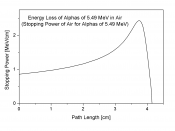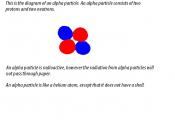In the year 1898 Thomson created the idea of atom as the positive charged ball in which there are negative charges placed - the "plum cake" model. So summing up whole a atom were to be neutral the
In the years 1909-1911 Ernest Rutherford and his students - Hans Geiger (1882-1945) and Ernest Marsden conducted some experiments to search the problem of alpha particles scattering by the thin gold-leaf. Rutherford knew that the particles contain the 2e charge. The experiment caused the creation of the new model of atom - the planetary model.
Rutherford suggested to hit the gold-leaf (picture no. 1) with fast alpha particles from the source 214Po. (The source R was in the lead lining F). The particles felt from the source on the gold-leaf E and were observed by the microscope M. The whole experiment was in the metal lining A and was covered with the glass plate P.
The instrument was attached to the footing B. The gold leaf was about 5*10-7 meter thick. The scientist knew that reckoning the scattering angle could say much about the structure of atoms of the gold-leaf.
Rutherford made a theoretical analysis of angles of scattering in accordance with Thomson's theory of atom and in accordance with his own theory. Rutherford assumed that the charge of the nucleus was concentrated at its centre and devised a formula for how many particles would be deflected in each direction. The results matched this formula extremely well - lending support to Rutherford's model. Then his theoretic calculations he compared with the experiment result. Alpha particles going through atom created in accordance with the "plum cake" model wouldn't be strong abnegated because the electric field in that atom wouldn't be strong. In the model created by Rutherford the field is much stronger...


